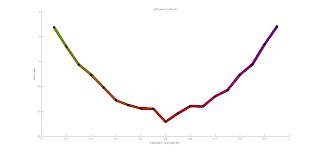- Equal width binning
- Predefined number of cut points per dimension (m)
- Number of dimensions (n)
- For each sequence node, there are (m+1)n history nodes => lots of nodes!
- Used for the tree and to update the particle filter
- Based on [1]
- Actions: move forward, turn left, turn right, turn around
- Reward: -1 per action
- Observations: 4 wall detection sensors (with Gaussian noise), 1 landmark / goal detection sensor
- Belief: location of agent (agent's orientation is known)
- Initial belief distribution: uniform over all free cells
- Currently available maps (0 = free, 1 = wall, G = goal, L = landmark):
- 0000G
- 00000000000
11L1L1L1G11
[1] Michael Littman, Anthony Cassandra, and Leslie Kaelbling. Learning policies for partially observable environments: Scaling up. In Armand Prieditis and Stuart Russell, editors, Proceedings of the Twelfth International Conference on Machine Learning, pages 362--370, San Francisco, CA, 1995. Morgan Kaufmann.
Tree Visualization






















































